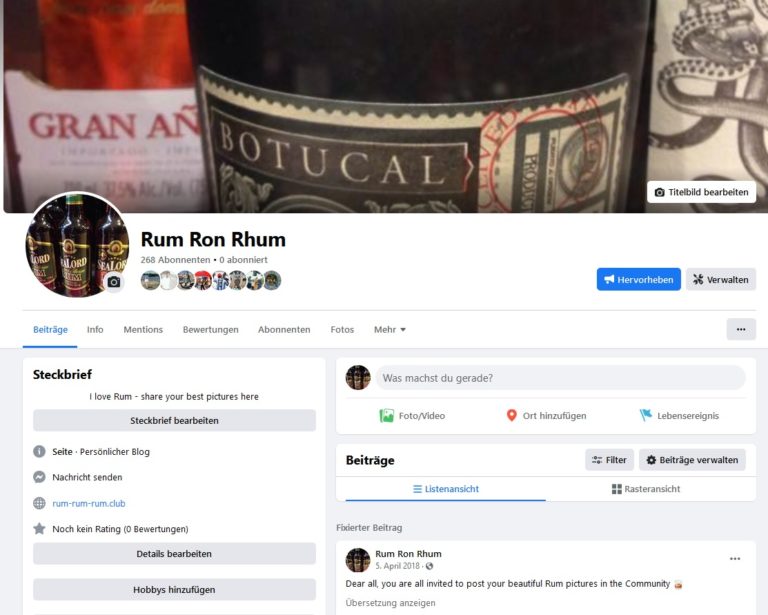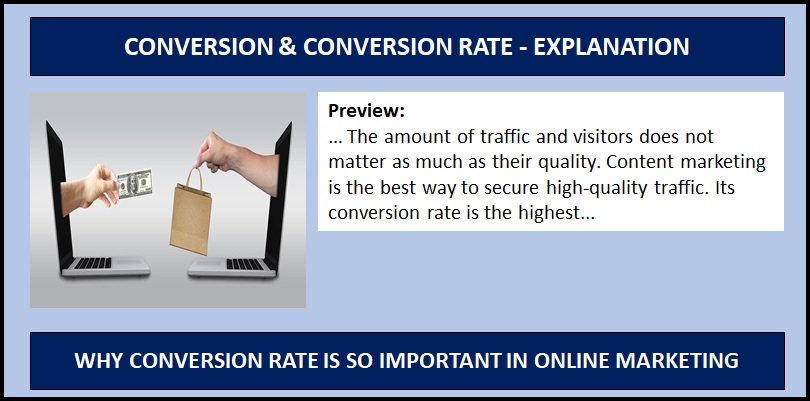In the field of online marketing, the conversion rate is one of those variables that everyone is chasing. Numerous activities are aimed at improving it. Therefore, in this article we will show what conversion actually is and which methods can be used to improve it. I will show case studies from my own sites as a blogger, as well as from other companies that have been successful in this area.
What is conversion?
In online marketing, the term conversion has become established for when a visitor performs a desired action: Purchase, newsletter subscription, registration with his data, asking a question, leaving a rating and the like.

Why is it called conversion in online marketing?
In online marketing, this term has become established because a customer is gained from an anonymous visitor to a website or a social media platform, or someone who shows interest or at least carries out some form of interaction.

Why is conversion so important in online marketing?
Making sales on the Internet really started in the year 2000, when the web became more widespread in households. There, you realised that you were dealing more and more with anonymous visitors about whom you knew next to nothing. The quantity of these visitors was important, but not the decisive point. Because with the help of advertisements, advertising banners, it was possible to buy their number in a targeted way. Later, much more through ads in the social media. But all this was of no use at all if these people did not buy anything or at least stood out from the unknown masses. Therefore, the ultimate goal in online marketing has always been to have a conversion.
What is the conversion rate?
The conversion rate is the proportion of those who can be converted from the number of all visitors into customers or interested parties. It is given as a percentage and is calculated according to this formula:
Conversion rate = number of conversions achieved / number of all visitors

Why is the conversion rate more important than traffic?
This discipline of “online marketing” is not that old. Therefore, the experts themselves first had to gain experience on how it should all work. Moreover, developments were influenced by technological advances, so the rules were rewritten. When Google entered the world stage in 1998, websites were struggling to generate visitors. After the introduction of paid search results in 2000, this problem was immediately solved. With the help of the search engine and the paid search “AdWords”, every website operator could in principle buy visitors at any time. But it turned out that a lot of mass does not always help. Because mass is not enough, but the quality of the visitors was decisive. This drastically influenced the conversion rate. From this realisation, two sub-areas of online marketing developed, both aimed at improving the conversion rate:
Data analysis and target group identification
Website operators had a great interest in knowing their visitors better. The aim was to identify website visitors in order to know their interests and buying behaviour better. The more you could find out about them, the better it was possible to provide them with the best offers. In addition, they became more accessible for later measures. For this purpose, the following means were used, for example:
Google made the Google Analytics tool available from that year onwards. With it, operators of websites or online shops could obtain some information about their anonymous visitors. The tool provided very comprehensive overviews. For example, it showed from which cities most visitors came. If Google had the data, it also showed whether they were men or women – including age groups. It gave an insight into the visiting times of individual pages. See the video here:
They started displaying forms where interested people could sign up. This way they were registered for the newsletter. In this way, the operators could actively seek contact with them.
Another method was to offer clubs, memberships or closed areas. There, the interested parties had to register with a whole range of their personal data.
The Leadinfo programme makes it easier to identify returning visitors. Especially interesting in the B2B sector to know who might be looking for products on the pages. This way you can address them specifically. See here:
Later, social media entered the market. With the help of Facebook, Instagram, YouTube, etc., companies got the opportunity to build communities. Tools like Insights run in the background, where they then get data about their fans.
Content marketing
The second method became what is now known as content marketing. Until the turn of the millennium, there was mostly classic advertising on TV, radio or print media. It worked like this: You place ads and deliver them to a huge amount of people. Maybe 10% of them are interested. These 10% then buy something. If the return is higher than the cost of advertising, then it was a profit. So this kind of marketing was a kind of forced sonication. Always hoping to meet enough people who fit the target group.
But with the emergence of Google and YouTube, people started to approach it from the other direction. The customer should approach the seller. Webmasters and film artists began to create content that provided valuable information to a specific target group. Not advertising, but actual content that they could use to provide meaningful value to a select group of people. This content was then well placed by YouTube or by the Google search algorithm. So all by itself they led lots of traffic there. The great advantage of this was that the traffic was perhaps somewhat less than through traditional advertising. But it was almost exclusively people who came from the exact target group. So they were interested in buying from the outset and did not have to be persuaded first. It was found that content marketing led to a massive increase in the conversion rate. Thus, this method became the one that is now the most dominant on the web.
Increase conversion rate – Case Studies / Case Studies
Here are some examples from online marketing practice on how to influence conversion so that it improves.
Case Study #1 – Generating more revenue with GoogleAds click advertising
In the years around 2010-2013, this blog was still making a lot of money with Google AdSense. The reason for this was that Facebook had not yet pulled so many advertising billions from Google. At that time, the ads were still placed manually by code on a page. As a blogger, you had the choice of inserting them in the text, on the left margin, on the right in the sidebar, in the footer, and so on. It was my main source of income in those years.
Once I read a statistic about how when you write a blog post, about 90% of the readers stick with it for the first 2 paragraphs. But by the end of the article, that reduces to 20%-30% in some cases. So I got a plugin to automatically insert the AdSense code after the first paragraph of each blog article. Immediately, my AdSense earnings shot up threefold. So many more of my visitors were now making a click. And that’s only because the ad unit was in the right place.
Case study #2 – The newsletter lives
On many websites there is a link to subscribe to the newsletter. But this is not used as extensively as a small pop-up window that opens after about 10 seconds on the website. There is often a text like: “Subscribe and download our free ebook”. On most pages, the window leads to a significantly higher rate of newsletter use.
And this works very well as a sales tool. The reason for this is that subscribers express their interest in a topic on their own initiative. In this way, companies build up a large pool of people whose likelihood of buying is basically even higher than with normal visitors. Over the years, a mountain of addresses accumulates to whom companies send a message with a single click. This is an inexpensive way to reach thousands of people in a short period of time.
Case Study #3 – Improving User Experience – UX Design Optimisation
User experience refers to everything the user experiences when visiting a website: user guidance, menus, images, font size, advertising, colours – simply everything. Research has shown that there are several good practices in this area and there are also many bad designs. Therefore, websites should be designed in such a way that they are easy to read for the user and make sense in terms of operation. Research shows that this aspect massively improves the conversion rate. Because there is good content on many pages. But on some of them it is made difficult for the user to enjoy it properly. See the video here:
Case Study #4 – Rum Niche Site
I have raised quite a few niche sites over my years. One of them was about rum. Since I took numerous pictures for my website, I thought it would make sense to post them on Facebook as well. So I created a page for my domain:

Dort zeigte ich Fotos von Rum Flaschen, denen ich irgendwo begegnete. Innerhalb kurzer Zeit kamen schon erste Abos zustande. Rum Trinker aus aller Welt kamen vorbei und wurden Fans. Hin und wieder konnte ich den einen oder anderen Affiliate Link unterbringen. Dieser sorgte immer sofort für ein klein wenig Umsatz.
Fazit zum Thema Conversion und Conversion Rate
Die Menge an Traffic und Besuchern spielt keine so große Rolle wie deren Qualität. Content Marketing ist die beste Möglichkeit, um sich qualitativ hochwertigen Traffic zu sichern. Dessen Conversion Rate liegt am höchsten.
